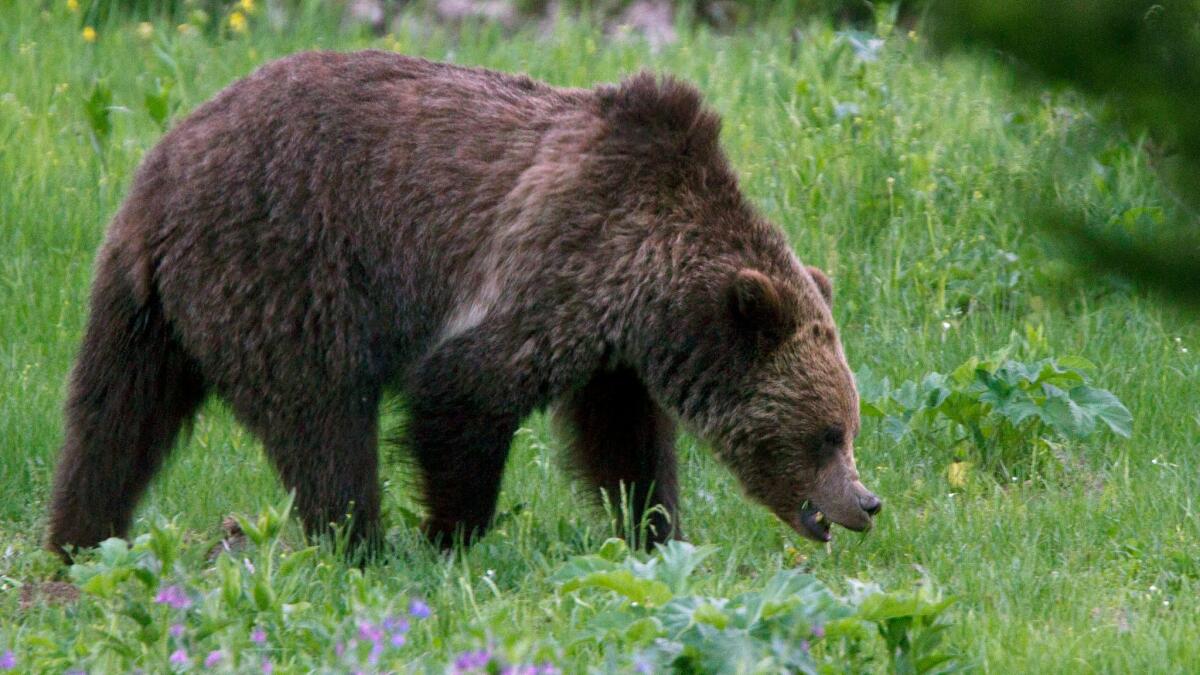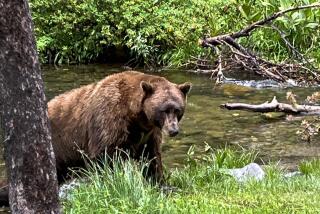Conservationists and tribes denounce U.S. plan to remove Yellowstone grizzly bears from endangered species list

The grizzly bear in Yellowstone National Park has been protected by the federal government for more than four decades.
That will begin to change next week.
For the record:
9:58 p.m. Nov. 16, 2024An earlier version of this article reported that grizzly bears had not been observed in California since the 1990s. They were last seen in the 1920s.
Interior Secretary Ryan Zinke this week said the agency intends to remove grizzlies living in the Yellowstone area from Endangered Species Act protection. The change will be entered into the federal registry next week and can take effect 30 days from that point.
The move was decried by several conservation groups and Native American tribes who feared the delisting of the grizzly would lead states to open up hunting season on the bears in the protected Yellowstone zone, which reaches into Idaho, Wyoming and Montana.
Jonathan Proctor, Rockies and Plains program director for Defenders of Wildlife, said Friday that populations of grizzlies remain in isolated ecosystems and need continued federal protections to grow and connect with other pockets of bear populations to increase genetic diversity and help sustain the species.
“The ongoing recovery of the Yellowstone population shows how we can bring a species back from the brink,” he said. “But we are concerned about the actions of states after a delisting. We can’t let the work of saving these bears go down the drain.”
Stan Grier, chief of the Piikani Nation of the Blackfoot Confederacy, described the decision in cultural terms.
“This announcement is no doubt being celebrated by trophy hunters like Don Jr. and Eric Trump, and the president’s extractive industry cronies, but for us it is an act of cultural genocide,” Grier said. Calling the grizzly a “sacred being that protects our sacred lands,” he added, “this is a struggle for the very spirit of the land — a struggle for the soul of all we have ever been, or will ever become.”
Grizzly bears number close to 700 in what’s known as the Greater Yellowstone Ecosystem, which expands well beyond the park’s boundaries, according to Hilary Cooley, grizzly bear recovery coordinator with the U.S. Fish and Wildlife Service.
She said that in 1975, the grizzly population numbered about 130 — having being hunted and killed with relative impunity for decades prior. The restrictions and protections put in place by the Endangered Species Act allowed the bear population — which reproduces at a relatively slow rate — to climb steadily over the decades.
This announcement is no doubt being celebrated by trophy hunters like Don Jr. and Eric Trump ... but for us it is an act of cultural genocide.
— Stan Grier, chief of the Piikani Nation of the Blackfoot Confederacy
Now with the population more than five times what it was 42 years ago, the Fish and Wildlife Service “has met recovery criteria,” Cooley said. Biologists with the agency believe they have given the bears a path forward for sustainability.
Removing the Yellowstone population from the endangered species list, Cooley said, allows Fish and Wildlife to focus on the recovery efforts of hundreds of other species — including other pockets of grizzly populations — currently protected under the Endangered Species Act.
She said that there are about 1,000 grizzly bears in the Northern Continental Divide Ecosystem and that the agency would next focus on whether grizzlies in that region are ready for delisting. There are four other areas in the Washington-Idaho-Montana area where grizzlies enjoy protection — though in two of them, biologists haven’t reported any bear populations.
Grizzly bears as a species will remain protected under the Endangered Species Act in all Lower 48 states, so once an area is delisted, bears would still be protected in locations outside that area.
Natural Resources Defense Council senior attorney Rebecca Riley said it’s too soon to allow any kind of hunting season for grizzly bears.
“This population is still so small that any hunting would be a problem,” she said. “We need the population to continue to grow bigger and more genetically diverse.”
She said that can only happen by allowing the bears’ population density to expand and ultimately connect with other isolated bear populations near Glacier National Park in Montana. But unlike wolves, which travel vast distances, grizzlies don’t wander far — making connections with other bear groups a longer process.
Ben Nuvamsa, former head of the Hopi tribe, was angered by the decision. In a statement, he called the move to delist the grizzly a “regression to the Old West frontier mentality.”
“The grizzly bear, historically, is a religious icon to virtually all tribal nations,” he said. “The Fish and Wildlife Service promised us that it would conduct full and meaningful consultation with us, but it turns out, those were only empty promises.”
Grizzlies once numbered about 50,000 when Lewis and Clark explored the West in the early 1800s, but as cities and towns expanded and developed, the bear population declined steeply. Prior to being listed as an endangered species, the bears were subject to trophy hunts.
Several areas, including California, once had abundant grizzly populations. California, however, hasn’t seen a grizzly since the 1920s, despite it being the symbol on the state’s flag. There have been proposals to reintroduce the grizzly to parts of the Golden State, but none has been tried to date.
Proctor said state actions once the bears are delisted remain a key concern.
The Idaho Legislature passed a law, signed in March by Republican Gov. C.L. “Butch” Otter, that would allow owners of pets and livestock to kill a grizzly if they believed the bear was threatening their animals. The law would apply to people living within the Yellowstone ecosystem but outside the national park boundary — and only once delisting occurred.
Proctor said laws like that suggest states won’t take the grizzly bear’s long-term health into consideration.
But if protections remain in place, he said, “then the grizzlies will do the rest” and continue to rebound. “But that’s a big question — will these states allow them to thrive or will they add to increased mortality? We will be monitoring it closely.”
Twitter: @davemontero
ALSO
Jury deadlocks in Ohio police officer’s murder case retrial
Atty. Gen. Jeff Sessions wants to get tough on crime. These people think he’s got it all wrong
More to Read
Sign up for Essential California
The most important California stories and recommendations in your inbox every morning.
You may occasionally receive promotional content from the Los Angeles Times.











